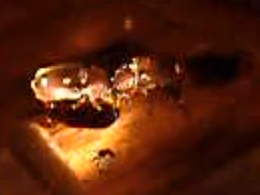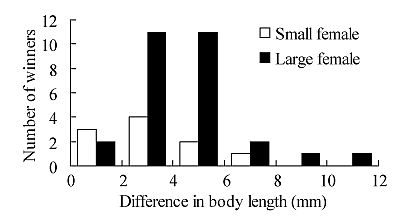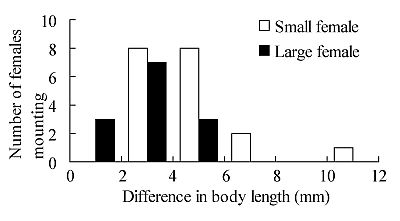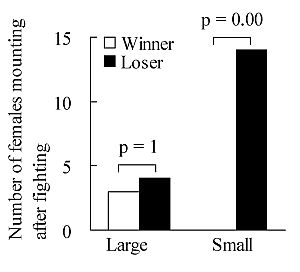生物科学研究所研究報告
2025 年 2 月 16 日
カブトムシ雌の闘争行動と同性間マウンティング
井口豊(生物科学研究所)
Report of Laboratory of Biology
February 16, 2025
Female-female fighting and mounting in the horned beetle Trypoxylus dichotomus septentrionalis
Yutaka Iguchi
Laboratory of Biology
PDF version
DOI: 10.5281/zenodo.14281281
Abstract
Females of the Japanese horned beetle, Trypoxylus dichotomus septentrionalis, have only small horns, but they often fight over access to feeding sites by head-butting each other (Iguchi, 2007, also see Fig. 1 and the video). However, they also show intrasexual mounting (so-called homosexual behavior
or same-sex behavior
). In this case, the mounting female extends her ovipositor towards the mounted female's genital organ as if she copulated (Fig. 2).
Female-female mounting in this species was first reported by Iguchi (1996), and then by Tanaka (1999) and Abe et al. (2006).
Iguchi (2010) examined the relationship between the body size of females and the outcome of their fights and mountings. The results showed that female body size had different effects on the outcome of their fights and mountings. It seemed natural that large females more often won fights to gain access to food than small females (Fig. 3). However, it was surprising that small females more often mounted large females (Fig. 4).
Small females mounted large females significantly more often after losing than after winning fights (Fig. 5). It was interesting that small females that mounted large females after losing a fight were as successful at gaining access to food as those that won fights (food acquisition after mounting, 4/19 = 21%; after winning, 10/38 = 26%; Fisher's exact test, p = 0.75).
These results suggest that female mounting may function as a tactic for reducing intrasexual fighting between small and large females.
References
Abe H., Fujii T., Suzuki A., Sato T., Iwabuchi K. & Obara Y. (2006) Elicitation of male mating behavior in females in insects: The cases of Japanese horned beetle, a long-horned beetle, a silk worm and other. Japanese Journal of Sexuology, 24: 7-16 [in Japanese with English abstract].
Iguchi Y. (1996) Sexual behavior of the horned beetle, Allomyrina dichotoma septentrionalis (Coleoptera, Scarabaeidae). Japanese Journal of Entomology, 64: 870-875.
Iguchi (2007) Female-female fighting behavior of the Japanese horned beetle. Movie Archives of Animal Behavior, Data No. momo071108td01b. DOI: 10.5281/zenodo.10682701. ResearchGate.
Iguchi Y. (2010) Intrasexual fighting and mounting by females of the horned beetle Trypoxylus dichotomus (Coleoptera: Scarabaeidae). European Journal of Entomology, 107: 61-64.
Tanaka Y. 1999: Pseudocopulation behavior in female Allomyrina dichotoma septentrionalis. Gekkan-mushi, 346: 37-38 [in Japanese].

Fig. 1. Female-female fighting over food in Trypoxylus dichotomus septentrionalis (adopted from Iguchi 2007). You can see the original video on Movie Archives of Animal Behavior.

Fig. 2. Intrasexual mounting by females of Trypoxylus dichotomus septentrionalis. This is also called homosexual behavior or same-sex behavior. The mounting female is extending her ovipositor towards the mounted female's genital organ as if she were copulating (adopted from Iguchi 2010).

Fig. 3. The effect of female body size on the outcome of intrasexual fighting (adopted from Iguchi 2010).

Fig. 4. The effect of female body size on the outcome of intrasexual mounting (adopted from Iguchi 2010).

Fig. 5 The effect of female intrasexual fighting on intrasexual mounting (adopted from Iguchi 2010).
カブトムシ雌の同性間闘争に対するマウンティングの役割
日本のカブトムシ Trypoxylus dichotomus septentrionalis では,エサを得るために,雄だけでなく雌もまた同性間で闘争をする(Fig. 1),井口,2007も参照)。しかしながら,そのとき雌は,同性間でマウンティングも示す(Fig. 2)。このとき,マウンティングする雌は,まるで交尾するかのごとく,マウンティングされる雌に産卵管を伸ばす。
私は,このようなカブトムシ雌の同性間マウンティングを初めて報告し(Iguchi, 1996),その後,田中(1999),阿部ら(2006)もこの行動を報告した。
その後,カブトムシ雌のサイズが,同性間闘争とマウンティングに与える影響について調べたところ,サイズが両者に全く異なる影響を与えることが分かった(Iguchi, 2010)。
大きな雌が小さな雌との闘争に勝ち,エサを得るのは当然の結果と言えよう(Fig. 3)。しかし,小さな雌ほど,大きな雌にマウントする傾向があるのは興味深い(Fig. 4)。
さらに,小さな雌は,大きな雌との闘争に勝った後よりも,負けた後にマウンティングを示すことが分かった(Fig. 5)。闘争に負けた後にマウンティングを示した小さな雌は,闘争に勝った小さな雌と同じくらいの割合でエサを得るのに成功した(マウンティング後のエサの獲得, 4/19 = 21%; 闘争に勝った後のエサの獲得, 10/38 = 26%; Fisher's exact test, p = 0.75)。
これらの結果は,カブトムシ雌の同性間マウンティングが,小さな雌と大きな雌の間の闘争を軽減する役割を果たしているかもしれないことを示唆する。
カブトムシの場合,雄は,雌のサイズにかかわらず,配偶行動を示すことが示唆されている(井口,2001)。小さな雌が頻繁に同性間配偶行動を示すのは,それが餌場に残り,雄と交尾をする上での利点となるかもしれない。
関連サイト
Intrasexual behavior in beetles カブトムシ雌の同性間配偶行動
カブトムシ雄の角長と闘争頻度について
DOI: 10.5281/zenodo.14134052
日本のカブトムシは Allomyrina か Trypoxylus か? 属名変更を巡って.
DOI: 10.5281/zenodo.14038791
参考文献
阿部広明,藤井告,鈴木文,佐藤俊幸,岩淵喜久男,小原嘉明(2006)昆虫の雌に引き起こされる雄の行動:カブトムシ,カミキリムシ,カイコなどの例.日本性科学会雑誌 24: 7-16.
Iguchi Y. (1996) Sexual behavior of the horned beetle, Allomyrina dichotoma septentrionalis (Coleoptera, Scarabaeidae). Japanese Journal of Entomology 64: 870-875.
井口豊(2001)カブトムシ雄の配偶行動と配偶者選択.昆虫と自然 36 (4): 44-46. ResearchGate.
井口豊(2007)カブトムシの雌間の闘争行動.動物行動の映像データベース, Data No. momo071108td01b. DOI: 10.5281/zenodo.10682701 ResearchGate.
Iguchi Y. (2010) Intrasexual fighting and mounting by females of the horned beetle Trypoxylus dichotomus (Coleoptera: Scarabaeidae). European Journal of Entomology 107: 61-64.
田中保明(1999)カブトムシ♀の擬似交尾行動を観察.月刊むし 346: 37-38.